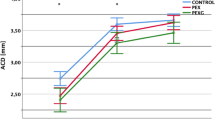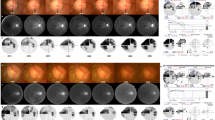Abstract
Purpose
To investigate the prevalence of glaucoma and coronary artery disease (CAD) in patients with cataract and pseudoexfoliation (PEX) syndrome.
Methods
Cross-sectional study of 2140 consecutive patients with cataract admitted at the University Hospital of Patras, Greece, for cataract surgery. Only patients with senile cataract were included in this study. All patients underwent a complete ophthalmological examination that included slit-lamp evaluation with dilated pupil for PEX material in the anterior segment, intraocular pressure (IOP) measurements, and optic disc cup examination. They also underwent an evaluation for CAD by a cardiologist. CAD was considered present if a patient had a history of myocardial infarction, or ischaemia, or abnormal coronary angiography. The patients were classified into two groups: the PEX and the non-PEX group.
Results
One thousand and eighty-eight (50.8%) patients were men and 1052 (49.2%) were women. The overall prevalence of PEX syndrome was found to be 27.9% and it was found to increase with progressing age. Bilateral PEX was more frequent than unilateral PEX, with the percentage of bilateral PEX raising with progressing age. A total of 132 patients (22.1%) in the PEX group exhibited glaucoma, while in the non-PEX group only 2.5% suffered glaucoma. PEX was also found to be positively associated with the risk for CAD among subjects 50 years or older. No association between CAD and glaucoma was found.
Conclusions
PEX syndrome constitutes a major glaucoma risk factor and a CAD risk factor. Patients with PEX should be informed and examined frequently as the risk is present throughout.
Similar content being viewed by others
Log in or create a free account to read this content
Gain free access to this article, as well as selected content from this journal and more on nature.com
or
References
Ringvold A . Epidemiology of the pseudo-exfoliation syndrome. Acta Ophthalmol Scand 1999; 77: 371–375.
Forsius H . Prevalence of pseudoexfoliation of the lens in Finns, Lapps, Icelanders, Eskimos and Russians. Trans Ophthalmol Soc UK 1979; 99: 296–298.
Forsius H . Exfoliation syndrome in various ethnic populations. Acta Ophthalmol Suppl 1988; 184: 71–85.
Schlotzer-Schrehardt UM, Koca MR, Naumann GO, Volkholz H . Pseudoexfoliation syndrome. Ocular manifestation of a systemic disorder? Arch Ophthalmol 1992; 110: 1752–1756.
Gartaganis SP, Georgakopoulos CD, Exarchou AM, Mela EK, Lamari F, Karamanos NK . Increased aqueous humor basic fibroblast growth factor and hyaluronan levels in relation to the exfoliation syndrome and exfoliative glaucoma. Acta Ophthalmol Scand 2001; 79: 572–575.
Gartaganis SP, Georgakopoulos CD, Mela EK, Exarchou A, Ziouti N, Assouti M et al. Matrix metalloproteinases and their inhibitors in exfoliation syndrome. Ophthalmic Res 2002; 34: 165–171.
Zenkel M, Kruse FE, Junemann AG, Naumann GOH, Schlotzer-Schrehardt U . Clusterin deficiency in eyes with pseudoexfoliation syndrome may be implicated in the aggregation and deposition of pseudoexfoliative material. Invest Ophthalmol Vis Sci 2006; 47: 1982–1990.
Ritch R, Schlotzer-Schrehardt U . Exfoliation syndrome. Survey Ophthalmol 2001; 45: 265–315.
Schlotzer-Schrehardt UM, Naumann GO . Ocular and systemic pseudoexfoliation syndrome. Am J Ophthalmol 2006; 141: 921–937.
Repo LP, Terasvirta ME, Koivisto KJ . Generalized transluminance of the iris and the frequency of the pseudoexfoliation syndrome in the eyes of transient ischemic attack patients. Ophthalmology 1993; 100: 352–355.
Linner E, Popovic V, Gottfries CG, Jonsson M, Sjogren M, Wallin A . The exfoliation syndrome in cognitive impairment of cerebrovascular or Alzheimer's type. Acta Ophthalmol Scand 2001; 79: 283–285.
Bojic L, Ermacora R, Polic S, Ivanisevic M, Mandic Z, Rogosic V et al. Pseudoexfoliation syndrome and asymptomatic myocardial dysfunction. Graefes Arch Clin Exp Ophthalmol 2005; 243: 446–449.
Cahill M, Early A, Stack S, Blayney A, Eustace P . Pseudoexfoliation and sensorineural hearing loss. Eye 2002; 16: 261–266.
Mitchell P, Wang JJ, Smith W . Association of pseudoexfoliation syndrome with increased vascular risk. Am J Ophthalmol 1997; 124: 685–687.
Schumacher S, Schlotzer-Schrehardt U, Martus P, Lang W, Naumann GOH . Pseudoexfoliation syndrome and aneurysms of the abdominal aorta. The Lancet 2001; 357: 359–360.
Kozobolis VP, Papatzanaki M, Vlachonikolis IG, Tsambarlakis IG . Epidemiology of pseudoexfoliation in the island of Crete (Greece). Acta Ophthalmol Scand 1997; 75: 726–729.
Stefaniotou M, Petroutsos G, Psilas K . The frequency of pseudoexfoliation in a region of Greece (Epirus). Acta Ophthalmol (Copenh) 1990; 68: 307–309.
Konstas A, Dimitrakoulias N, Kourtzidou O, Filidis K, Bufidis K, Benos A . Frequency of exfoliation syndrome in Greek cataract patients. Acta Ophthalmol Scand 1996; 74: 478–482.
Vesti E, Kivela T . Exfoliation syndrome and exfoliation glaucoma. Prog Retin Eye Res 2000; 19: 345–368.
Roth M, Epstein DL . Exfoliation syndrome. Am J Ophthalmol 1980; 89: 477–481.
Hietanen J, Kivela T, Vesti E, Tarkkanen A . Exfoliation syndrome in patients scheduled for cataract surgery. Acta Ophthalmol (Copenh) 1992; 70: 440–446.
Teshome T, Regassa K . Prevalence of pseudoexfoliation syndrome in Ethiopian patients scheduled for cataract surgery. Acta Ophthalmol Scand 2004; 82: 254–258.
Hiller R, Sperduto RD, Krueger DE . Pseudoexfoliation, intraocular pressure and senile lens changes in a population-based survey. Arch Ophthalmol 1982; 100: 1080–1082.
Streeten BW, Bookman L, Ritch R, Prince AM, Dark AJ . Pseudoexfoliative fibrillopathy in the conjunctiva. A relation to elastic fibers and elastosis. Ophthalmology 1987; 94: 1439–1449.
Schlotzer-Schrehardt UM, Kuchle M, Naumann GOH . Electron-microscopic identification of pseudoexfoliation material in extrabulbar tissue. Arch Ophthalmol 1991; 109: 565–570.
Hammer T, Schlotzer-Schrehardt UM, Naumann GOH . Unilateral or asymmetric pseudoexfoliation syndrome? An ultrastructural study. Klin Monatsbl Augenheilkd 2000; 217: 100–108.
Kozart D, Yanoff M . Intraocular pressure status in 100 consecutive patients with exfoliation syndrome. Ophthalmology 1982; 89: 214–218.
Ringvold A, Blika S, Elsas T, Guldahl J, Brevik T, Hesstvedt P et al. The middle-Norway eye-screening study.II. Prevalence of simple and capsular glaucoma. Acta Ophthalmol (Copenh) 1991; 69: 273–280.
Puska PM . Unilateral exfoliation syndrome: conversion to bilateral exfoliation and to glaucoma: a prospective 10-year follow-up study. J Glaucoma 2002; 11: 517–524.
Atalar PT, Atalar E, Kilic H, Abbasoglu OE, Ozer N, Aksoyek S et al. Impaired systemic endothelial function in patients with pseudoexfoliation syndrome. Int Heart J 2006; 47: 77–84.
Citirik M, Acaroglu G, Batman C, Yildiran L, Zilelioglu O . A possible link between the pseudoexfoliation syndrome and coronary artery disease. Eye 2007; 21: 11–15.
Damji KF, Bains HS, Amjadi K, Dohadwala AA, Valberg JD, Chevrier R et al. Familiar occurrence of pseudoexfoliation in Canada. Can J Ophthalmol 1999; 34: 257–265.
Yuksel N, Anik Y, Kilic A, Karabas V, Demirci A, Caglar Y . Cerebrovascular blood flow velocities in pseudoexfoliation. Graefes Arch Clin Exp Ophthalmol 2006; 244: 316–321.
Sainz Gomez C, Moreno-Montanes J, Escudero Berasategui JM, Sadaba Echarri LM, Fernandez Hortelano A, Garcia Layana A . Prevalence and risk factors of pseudoexfoliation syndrome in institutionalized geriatric patients in Navarra. Arch Soc Esp Ophthalmol 2003; 78: 383–388.
Visontai Z, Merisch B, Kollai M, Hollo G . Increase of carotid artery stiffness and decrease of baroreflex sensitivity in exfoliation syndrome and glaucoma. Br J Ophthalmol 2006; 90: 563–567.
Vessani RM, Ritch R, Liebmann JM, Jofe M . Plasma homocysteine is elevated in patients with exfoliation syndrome. Am J Ophthalmol 2003; 136: 41–46.
Allingham RR, Loftsdottir M, Gottfredsdottir MS, Thorgeirsson E, Jonasson F, Sverisson T et al. Pseudoexfoliation syndrome in Icelandic families. Br J Ophthalmol 2001; 85: 702–707.
Hietanen J, Soisalon-Soininen S, Kivela T, Tarkkanen A . Evaluation of the clinical association between exfoliation syndrome and abdominal aortic aneurysm. Acta Ophthalmol Scand 2002; 80: 617–619.
Ringvold A, Blika S, Sandvik L . Pseudo-exfoliation and mortality. Acta Ophthalmol Scand 1997; 75: 255–256.
Shrum KR, Hattenhauer MG, Hodge D . Cardiovascular and cerebrovascular mortality associated with ocular pseudoexfoliation. Am J Ophthalmol 2000; 129: 83–86.
Netland PA, Ye H, Streeten BW, Hernandez MR . Elastosis of the lamina cribrosa in pseudoexfoliation syndrome with glaucoma. Ophthalmology 1995; 102: 878–886.
Ringvold A, Vegge T . Electron microscopy of the trabecular meshwork in eyes with exfoliation syndrome. (Pseudoexfoliation of the lens capsule). Virchows Arch (Pathol Anat) 1971; 353: 110–127.
Streeten BW, Li ZY, Wallace RN, Eagle RC, Keshgegian AA . Pseudoexfoliative fibrillopathy in visceral organs of a patient with pseudoexfoliation syndrome. Arch Ophthalmol 1992; 110: 1757–1762.
Author information
Authors and Affiliations
Corresponding author
Rights and permissions
About this article
Cite this article
Andrikopoulos, G., Mela, E., Georgakopoulos, C. et al. Pseudoexfoliation syndrome prevalence in Greek patients with cataract and its association to glaucoma and coronary artery disease. Eye 23, 442–447 (2009). https://doi.org/10.1038/sj.eye.6702992
Received:
Revised:
Accepted:
Published:
Issue date:
DOI: https://doi.org/10.1038/sj.eye.6702992
Keywords
This article is cited by
-
Nasal mucociliary clearance and hearing loss in pseudoexfoliation syndrome
European Archives of Oto-Rhino-Laryngology (2021)
-
Exfoliation Syndrome in Egypt: Prevalence and Association with Cataract in a Large Cohort
Ophthalmology and Therapy (2021)
-
Paraoxonase 1 (PON1) promoter (−107T/C) and coding region (192Q/R and 55L/M) genetic variations in pseudoexfoliation syndrome and pseudoexfoliative glaucoma risk
Graefe's Archive for Clinical and Experimental Ophthalmology (2019)
-
Transmission electron microscopy study of undescribed material at the anterior lens capsule in exfoliation syndrome
Graefe's Archive for Clinical and Experimental Ophthalmology (2018)
-
Ocular Pseudoexfoliation Syndrome Linkage to Cardiovascular Disease
Current Cardiology Reports (2016)



